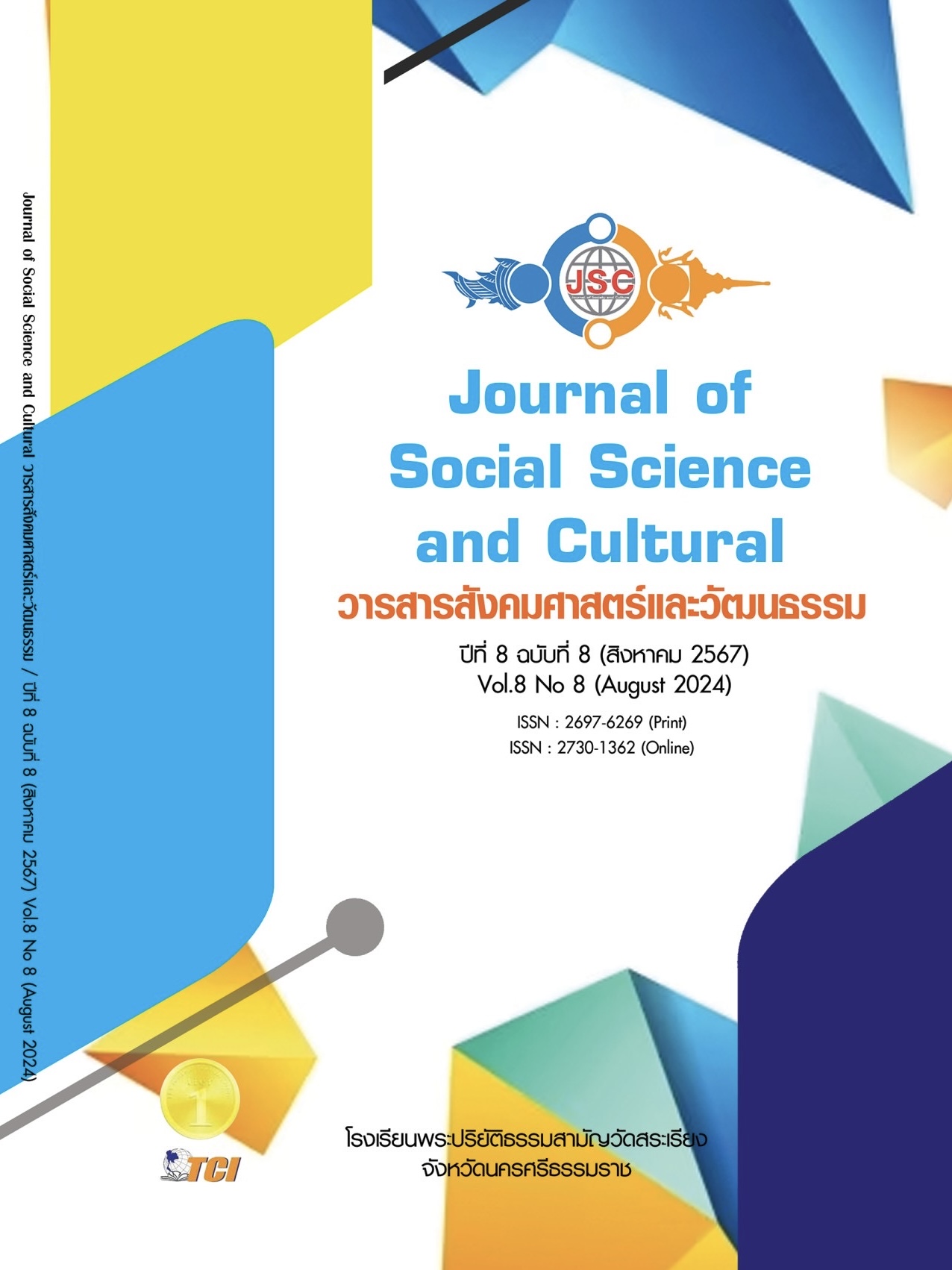MARKETING POTENTIAL AND NEEDS OF THAI HERBS IN SPA BUSINESS TO PROMOTE MEDICAL TOURISM
Main Article Content
Abstract
Research to study the marketing potential and demand for herbs among spa business operators. and study the behavior of using spa business services and the marketing mix (7Ps) of foreign tourists This research is a mixed methods research using interviews with business entrepreneurs. Using snowball sampling and 400 foreign tourists. distributed a specific questionnaire. Statistics used were percentage, mean, standard deviation. and Chi - Square test at significance level 0.05. Equal proportions of female and male entrepreneurs. The spa business model is a Day spa. Most of the spa business's customers are foreigners. Problems and obstacles of the spa business Personnel shortage with knowledge and expertise in spa business management The employee entry - exit rate is high. and the service aspect of skilled employees providing services that are hard to find in the market where competition is very high. Currently, there is no shortage of herbs like turmeric, plai, massage oil, compresses, tamarind, kaffir lime, balm, la - hei essential oil, etc. Gender is related to behavior regarding the purpose of using the service. Time period for using the service Personnel aspect that influences service use, price aspect, personnel aspect, physical aspect, and process aspect. Significantly at the 0.05 level, age and income are related to behavior regarding the purpose of using services. Time period for using the service Personnel that influence service use. The cost of using the service and the duration of the service. And age is significantly related to every aspect of the marketing mix (7Ps) at the 0.05 level.
Article Details
References
กระทรวงการท่องเที่ยวและกีฬา. (2567). สถิติการท่องเที่ยวประจำปี 2567. เรียกใช้เมื่อ 16 พฤษภาคม 2567 จาก https://www.mots.go.th/news/category/758
กระทรวงสาธารณสุข. (2559). สถานการณ์ทเกี่ยวของกับการพัฒนาอุตสาหกรรมยา สมุนไพรและชีววัตถุ. เรียกใช้เมื่อ 10 พฤษภาคม 2567 จาก https://cms-media.fda.moph.go.th/461152844465184768/2023/04/DB3tr65WDcj0hJxi2dZg6LDk.pdf
กรุงเทพธุรกิจออนไลน์. (2565). Global Wellness Institute (GWI) ชูเวลเนสไทยปักหมุดบน “ภูมิศาสตร์เวลเนส” เป็นประเทศที่ 3. เรียกใช้เมื่อ 15 กันยายน 2566 จาก https://www.pptvhd36.com/news/ประชาสัมพันธ์/180721
กรุงเทพธุรกิจออนไลน์. (2567). คาดปี 2567 "ท่องเที่ยวเชิงสุขภาพ" โตก้าวกระโดด 1 ล้านล้านเหรียญ. เรียกใช้เมื่อ 20 พฤษภาคม 2567 จาก https://www.bangkokbiznews.com/social/1006474
กฤติยา รุจิโชค. (2565). แนวทางพัฒนาศักยภาพการสื่อสารเพื่อการประชาสัมพันธ์ตลาดท่องเที่ยวสปาเพื่อสุขภาพในเขตพัฒนาการท่องเที่ยวชายฝั่งทะเลตะวันออกเพื่อเตรียมเข้าสู่การเป็นศูนย์กลางส่งเสริมสุขภาพแห่งเอเชีย. วารสาร มจร พุทธปัญญาปริทรรศน์ , 7(2). 47-58.
จุฑารัตน์ พิริยะเบญจวัฒน์. (2561). แนวทางการผลิตและพัฒนาบุคลากรเพื่อธุรกิจสปาไทย 4.0. วารสารวิทยาลัยดุสิตธานี, 12(พิเศษ), 383-385.
ชนิทร์ทิพย์ ดารากร ณ อยุธยา และคณ. (2564). กลยุทธ์การแข่งขันของธุรกิจสปาในประเทศไทย. วารสารวิชาการสถาบันวิทยาการจัดการแห่งแปซิฟิค, 7(1), 390-401.
ณัฐฐา สุขภักตร์. (2560). ปัจจัยส่วนประสมการตลาดที่มีผลต่อการเลือกใช้บริการสปาของผู้บริโภคในเขตบางนา. กรุงเทพมหานคร: บริหารธุรกิจมหาบัณฑิต มหาวิทยาลัยเกริก.
ประสพชัย พสุนนท์. (2553). สถิติธุรกิจ. กรุงเทพมหานคร: บริษัท สำนักพิมพ์ท้อป จำกัด.
มนต์ชัย วงษ์กิตติไกรวัล. (2561). ธุรกิจสปาไทยติด Top 5 ของเอเชีย แนะโรงแรมเพิ่มบริการรับเทรนด์. เรียกใช้เมื่อ 2 กรกฎาคม 2562 จาก https://thestandard.co/thai-spa-top-5-asian-spa/
มานิศา ผิวจันทร์. (2567). การท่องเที่ยวเชิงสุขภาพ: แนวโน้มกิจกรรมสุขภาพในกลุ่มโรงแรมและรีสอร์ต. Journal of Social Sciences and Humanities Research in Asia, 30(1), 105-122.
ยศวดี แขวัฒนะ และเสาวนีย์ สมันตรีพร. (2558). การพัฒนาธุรกิจสปาไทยสู่ความยั่งยืน: วิธีการทางจิตวิทยาบริการ. วารสารมหาวิทยาลัยกรุงเทพธนบุรี, 4(1), 174-184.
วสมน บุญรุ่ง. (2557). ความต้องการใช้บริการธุรกิจสปาของผู้ใช้บริการสปาในเขตกรุงเทพมหานคร. วารสารการวิจัยการบริหารการพัฒนา, 4(2), 15-23.
วาสนา อินทะแสง. (2559). พฤติกรรมผู้บริโภคและปัจจัยส่วนประสมทางการตลาดของธุรกิจคลินิกเสริม ความงามทีส่งผลต่อความภักดีของลูกค้า. ใน สารนิพนธ์บริหารธุรกิจมหาบัณฑิต สาขาบริหารธุรกิจ. มหาวิทยาลัยธรรมศาสตร์.
สุขุมาล ทองดี และณภัทร ส่งมหาชัย. (2566). รูปแบบการจัดการธุรกิจสปาเพื่อสุขภาพมหาวิทยาลัยการกีฬาแห่งชาติวิทยาเขตลำปาง. วารสารวิทยาลัยสงฆ์ลำปาง, 12(3), 156-172.
สุณีย์ ล่องประเสริฐ. (2557). การพัฒนามาตรฐานธุรกิจสปาในอําเภอเกาะสมุย จังหวัดสุราษฎร์ธานี สู่ประชาคมเศรษฐกิจอาเซียน. วารสารวิทยาการจัดการ มหาวิทยาลัยราชภัฏสุราษฎร์ธานี, 1(1), 125-141.
สุเนตรตรา จันทบุรี. (2559). โอกาสและความสามารถในการแข่งขันของธุรกิจสปาและนวดแผนไทย. วารสารเกษมบัณฑิต, 17(2), 49-63.
Chanthanawan, S. & Fongthanakit, R. (2019). Factors affecting decision making on using Spa services towards Consumers in Chatuchak District, Bangkok. Journal of the Association of Researchers of Thailand, 24(3), 190-204.
Junead, J. et al. (2018). The study on potential of Thai identity in spa business and traditional Thai massage toward world class health tourism sector. Panyapiwat Journal, 10(2), 1-16.
Larptaweesomboon, W. (2021). Determinant of consumer’s decision to select Sarisa Beauty Palace spa shop (Research Report). Bangkok: Ramkhamhaeng University.
Yamane, T. (1970). Statistic: An Introductory Analysis. (2nd ed). New York: Harper & Row.


